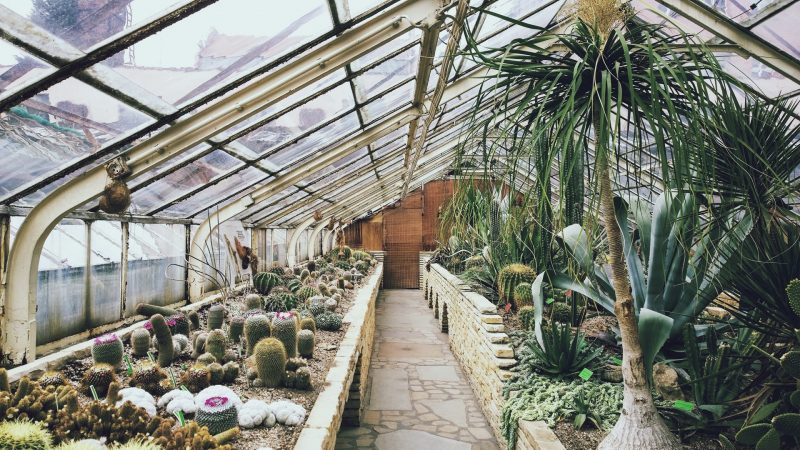If you’re wondering what temperature is too hot for a greenhouse, here’s what you need to know:
Your greenhouse is too hot if the temperature goes beyond 90 degrees F. Even the most heat-resistant plants and vegetables won’t survive this temperature. The ideal climate for plants to grow and thrive should be around 80 to 85 degrees F.

How Can You Lower the Temperature of a Greenhouse
If your greenhouse is too hot, here are some of the ways to lower the temperature:
Open the doors and windows
Let your greenhouse breathe. Open the doors and windows or roll up the plastic sheet to release to ventilate and provide air circulation.
Use fans
Using fans to cool down your greenhouse is better than opening doors and windows. Fans keep the hot air out and draw the fresh air in. For this method to be effective, make sure not to place the fans on the ceiling or ground level. You should place the fans around six feet high in front of vents to draw air over and through your plants.
Use shade
Another way to lower the temperature inside your greenhouse is to use shade. This blocks the blazing heat from the sun from entering your greenhouse. You can use a shade cloth, plant vines, or a liquid shading compound.
What Grows Well in a Hot Greenhouse?
Temperatures go up during summer, so it’s better to grow plants that thrive best in warm weather. Just make sure they get plenty of water so they’ll continue producing throughout the summer. Here are the following plants you should consider growing:
Greens
Greens grow well in warm weather. But if you want to hasten growth and harvest, it’s best to plant them in a greenhouse.
Melons
To grow sweet melons, you’ll need two to three months of warm, summer weather. Keep your plants moist, but make sure not to overwater, especially when the melons are starting to ripen. Adding too much water makes melons bland. Heirloom melons are deeply rooted in the soil, so they thrive best in heat and drought.
Corn
The hotter it gets, the faster the corn grows. However, you need to ensure that the soil is moist enough throughout the growing season. Corn absorbs a lot of water to form crunchy and sweet kernels.
Sweet Potatoes
While sweet potatoes are famous in the southern United States, northerners are beginning to catch up. Sweet potatoes thrive best in the heat, but just like other plants, they need to have even moisture. Don’t forget to harvest your sweet potatoes before the soil temperature goes below 55 degrees F.
Peppers
Compared to sweet bell peppers, hot peppers work better under prolonged heat. If you prefer sweet peppers, you can try planting Big Bertha, Cal Wonder, Cubanelle, and Sweet Banana.
Top Reasons Why You Should Invest in a Greenhouse
Greenhouses allow you to control the climate. You can ventilate during hot days, protect your plants from heavy rains and strong winds, and provide shade under the blazing sun. At the same time, you can also maintain the humidity levels to ensure that your plants grow healthy.
Here are some of the reasons why you should invest in a greenhouse:
Prevent pests
Harmful pests and critters can destroy all your hard work. By placing your plants in an enclosed space, you can prevent birds, deer, moles, aphids, mites, etc. from attacking your plants. Consequently, you wouldn’t need to use toxic pesticides or chemicals to ward off these critters.
A longer growing season
Greenhouses offer a longer growing season since it provides a more controlled climate. This enables you to plant weeks or months longer.
Protect plants from extreme weather
Placing your plants in a greenhouse protects them from harsh weather, such as heavy rain, strong winds, hail, storm, and blazing heat. As we’ve already established, greenhouses can shield the plants from the effects of temperature swings.
Strong winds and beaming rays of the sun can negatively affect the delicate plants if left exposed. Glass greenhouses or greenhouses with a plastic, translucent cover, diffuse the sunlight that hits your plants while ensuring that there’s enough ventilation throughout the space. Make sure to use a greenhouse to cover your plants and produce from harsh weather.
More plants to choose from
If you want to grow plants that aren’t native to your area, you should consider getting a greenhouse. As mentioned, you can easily control the temperature in a greenhouse so that you can offer a colder or warmer environment regardless of the weather outside.
The heat and insulation let you plant warm-season crops even if it’s the winter season. A greenhouse allows you to adjust the climate based on the plants you want to grow. All you have to do is to understand the conditions your plants need to grow and thrive.
Thoughts on the Answer to “What Temperature is Too Hot for a Greenhouse?”
Now that you know what temperature is too hot for a greenhouse make sure that your greenhouse’s temperature DOES NOT exceed 90 degrees F. Otherwise, your plants may shrivel up and die. Make sure that you know the perfect growing conditions for your plants and adjust your greenhouse accordingly.
